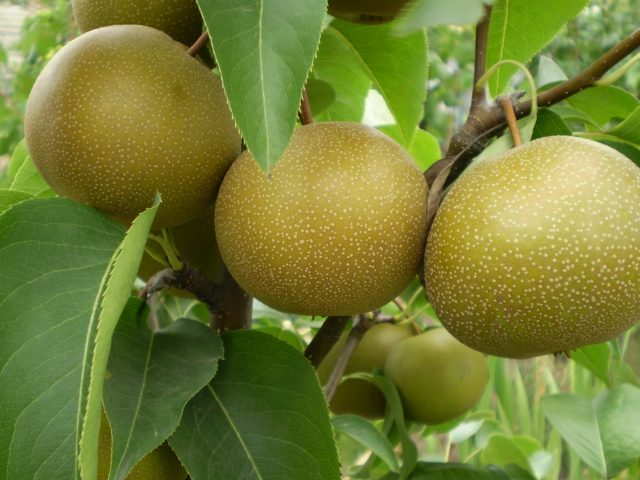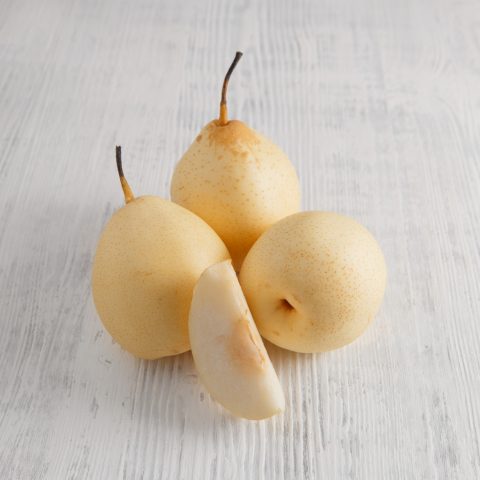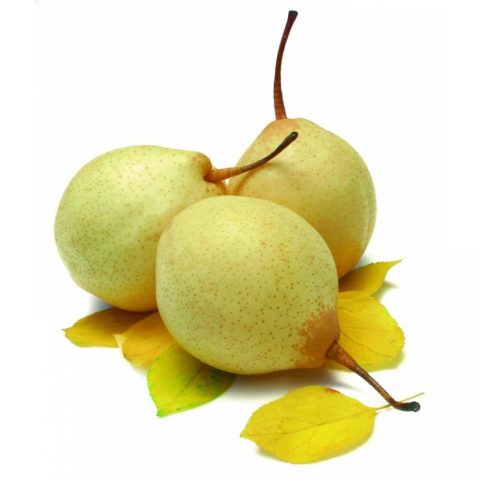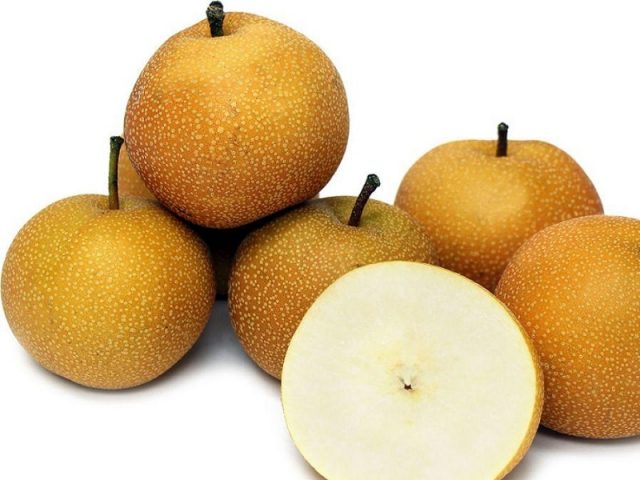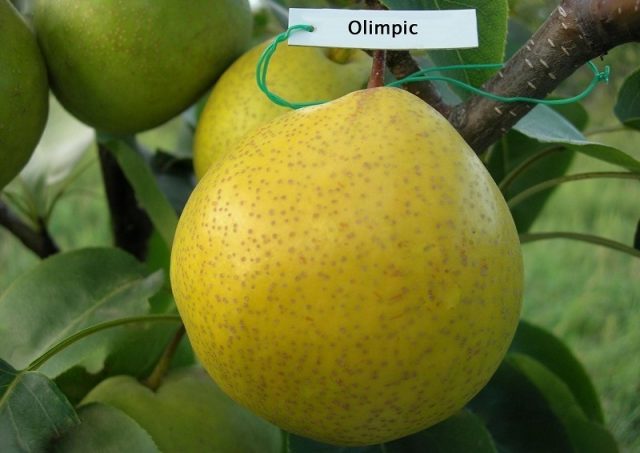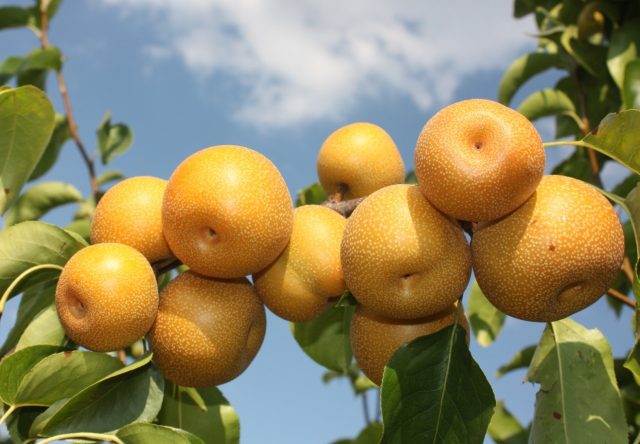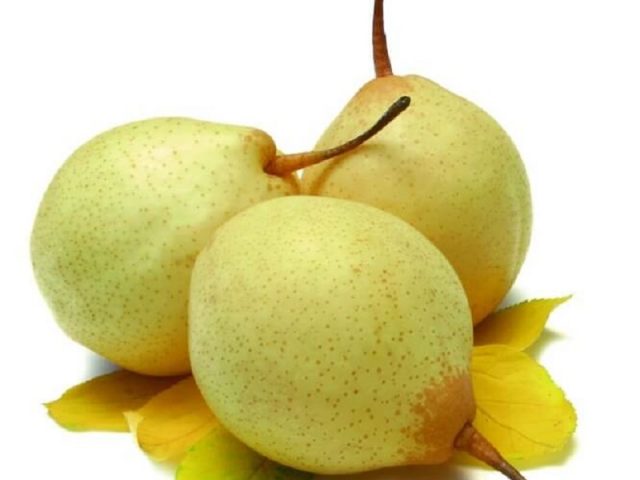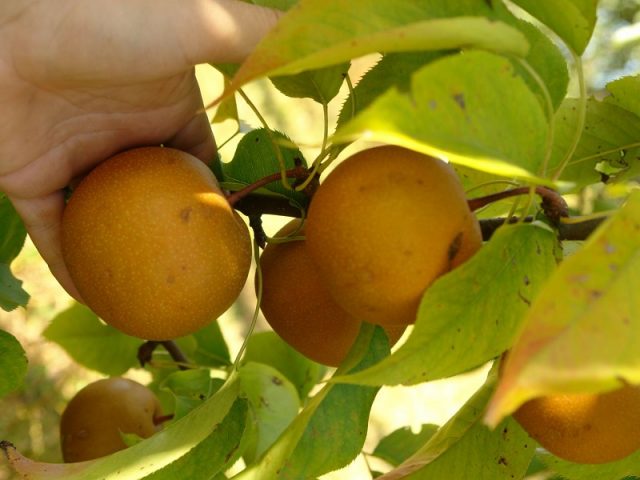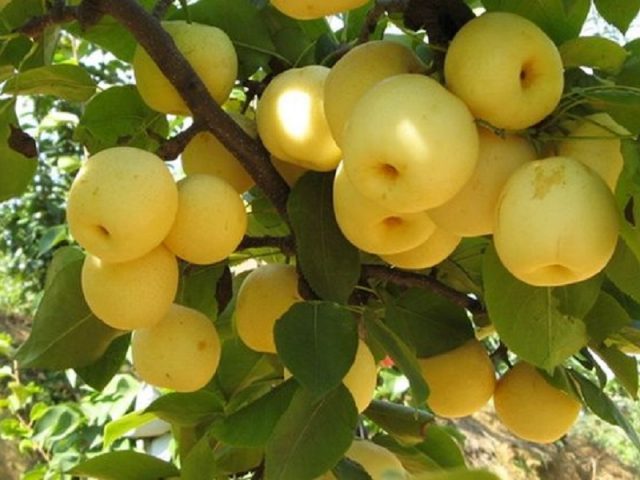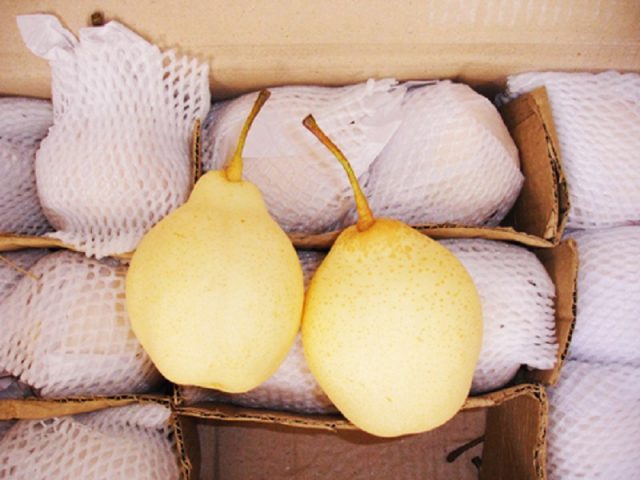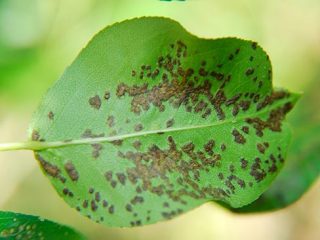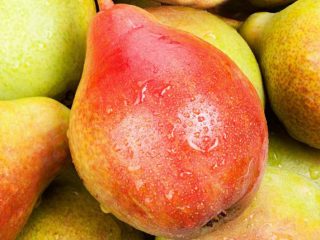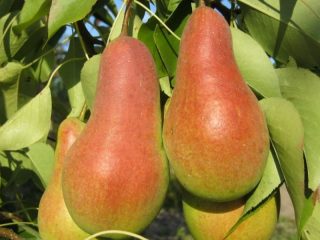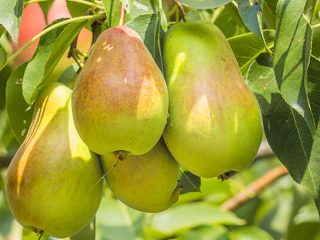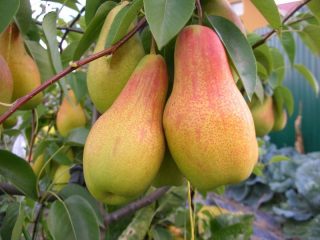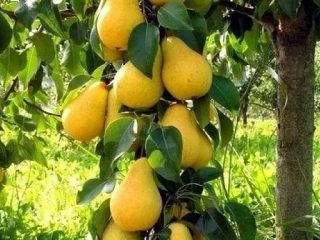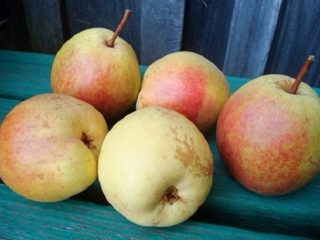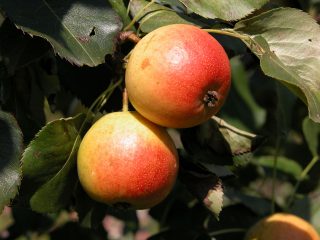Content
- 1 Where does the Chinese pear grow?
- 2 Description of Chinese pear
- 3 Chinese pear varieties
- 4 Features of planting and caring for the Chinese pear
- 5 What are the benefits of Chinese pear?
- 6 Harm of Chinese pear
- 7 Chinese pear during pregnancy and breastfeeding
- 8 How much does one Chinese pear weigh?
- 9 How many calories are in a Chinese pear?
- 10 Chinese Pear Recipes
- 11 Terms and conditions for storing fruits
- 12 Conclusion
Among the variety of pear varieties, the Chinese pear deserves special attention due to its wide range of technical characteristics, as well as tasty and healthy fruits. Growing the crop is becoming commonplace, and the number of fans of this luxurious tree is rapidly increasing every year.
Where does the Chinese pear grow?
The native habitat of the Chinese pear is China. In Russia, it is distributed only in the Primorsky Territory. The climatic conditions of other areas are not very suitable for this culture. But the correct choice of variety, proper planting and implementation of all agrotechnical care techniques will allow you to obtain healthy, tasty pear fruits in any region.
Description of Chinese pear
As a result of the work of breeders, the fruits of the Chinese pear inherited all the advantages of the forest analogue of Yamanashi, and were also provided with the excellent taste of ripe fruit. The resulting variety became the basis for breeding many varieties with different properties, which made it possible to obtain hybrids with high resistance to frost. Despite their differences, all varieties of Chinese pear have common characteristics.
The tree can be from 4 to 10 m tall and can fully grow and develop for 50 years. Almost all modifications are partially self-fertile. It follows from this that a pear tree will bear fruit even in the absence of pollinating plants, and at the same time will delight with high yields, which in the 5th year of the plant’s life are 60-80 kg per tree, and after 30 years - 200 kg. Any Asian pear - Bronze, Oriental - can act as a pollinator. It is important that its growing season coincides with the development of the Chinese pear.
The variety demonstrates excellent survival in the cold. For example, Kosu can withstand frosts down to - 35 °C. But Morning Freshness does not have such high durability, so it needs shelter for the winter.
Photos of the Chinese pear in the process of flowering are mesmerizing in their beauty. Pear fruits attract attention with a rounded shape and a rich, beautiful color, depending on the variety, which can vary from delicate green to a bronze hue. The fragrant pulp has a peach color, is juicy, uniform, but not soft. The fruits are characterized by a harmonious taste and delicate aroma.
Chinese pear varieties
A large number of varieties of Chinese pear allows you to choose the one that is optimal for cultivation in a particular region, climatic conditions, and soil. When choosing a variety of Chinese pear, you must also take into account the personal taste preferences of the gardener and his willingness to provide proper and timely care for the fruit crop.
Chinese pear Nashi
The variety of Chinese pear, which has the exotic name “Nashi”, is the result of selection, thanks to which the sour pear fruit with a solid structure acquired excellent taste characteristics and juiciness.
The fruit is round in shape and weighs up to 290 g. Its thin peel has a light yellow color and specific spots. The creamy pulp is characterized by juiciness, density, and has a characteristic crunch. The sweet taste with slight sourness makes this variety popular and in demand.
Fruits are not stored for a long time; after just a week, the product begins to turn black when left in the open air. If pear fruits are stored in a cool place, the shelf life increases to 2 weeks.
Kosu
A summer variety of Chinese pear that ripens in mid-July. A tree up to 4 m high. Fruiting occurs in the 3rd year, and under comfortable conditions, in the 2nd year after planting. The hybrid is considered self-pollinating, but in the presence of pollinators nearby, the yield indicators increase significantly. Kosu fruits are circle-shaped, bright bronze-gold in color with white dots. The average weight of one fruit is 130-160 g. The pulp is juicy and has a sweet taste. The disadvantage of this variety is its short shelf life, so the fruit should be used immediately after harvest.
Kosu has good resistance to bacterial diseases and scab. The pear tree is not afraid of frost and requires shelter for the winter only at very low temperatures.
Hosu
This variety is a columnar modification of the Chinese pear. Pear tree is small, up to 2 m tall. Fruit setting is observed on almost all lateral branches. Khosu is a self-pollinating variety, but for better yields you should not give up pollinators. The plant begins to produce fruits already in 2-3 years, the yield indicators are high and stable. The weight of one pear is up to 300 g. Under the bronze-colored skin there is very juicy but hard flesh. The high carbohydrate content of Chinese pear makes the taste sweeter and more delicate. The characteristics of this variety allow the harvest to be stored until December.
Hosu is able to withstand frosts up to 30 ° C, and also has good immunity to diseases and pests. The culture needs minimal care.
Olympic
An autumn variety that can be harvested as early as mid-September. It begins to bear fruit in the 2nd year. The variety needs pollinators. The fruits are circular in shape, green with a golden tint, with small gray patches on the skin. The weight of one pear is 160-200 g. The variety is valued for its balanced, sweet and sour taste and juicy, dense pulp. The harvest is stored until January.
Olympic demonstrates resistance to all types of scab and other bacterial infections.
Morning freshness
A summer variety of Chinese pear that bears fruit in early August with delicious, juicy pear fruits that are small in size, round in shape and yellow in color. The average weight of one fruit ranges from 115 to 180 g. The first harvest is formed after 3-4 years from the moment the seedlings are planted. Consumer period 2-3 weeks.
The variety has good winter hardiness, is not afraid of severe frosts and is rarely subject to diseases or pest attacks.
Khrustalnaya
One of the popular varieties of Chinese pear is the Crystal one. Valued for its high yield, resistance to temperature fluctuations and various fungi. The fruits have firm flesh of light yellow or white color. The thin peel has a sandy color and small light brown inclusions. The white Chinese pear ripens in the fall, during which time the harvest should be carried out.
Features of planting and caring for the Chinese pear
Planting should be done in the spring before the buds swell and sap begins to flow according to the standard scheme. The culture is very demanding on location, heat and moisture. Therefore, preference should be given to sunny, windless areas, since the ripening time of pears, their color and the formation of flower buds will depend on this.
The best yield is observed when seedlings of this variety are grown on substrates characterized by nutritional value and friability.
Planting stages:
- Dig a hole at least 60 cm deep. The roots of the seedling should fit freely into the planting hole, not be bent or twisted. Also, when planting, the distance between planting units must be maintained within 3 m.
- Pour drainage into the bottom of the hole, on top of which place a soil mixture containing organic matter.
- Form a hill in the center and drive a peg, which will become a reliable support for the young tree.
- Place the seedlings in the prepared hole on the north side of the peg, straightening the roots and sprinkling them so that the root collar is 5 cm above the soil surface.
- Compact the soil around the trunk well and water it abundantly.
- When the moisture is absorbed, mulch with sawdust and humus.
- Upon completion of planting, securely tie the seedling to the support.
You can grow a plant from seeds, read more at:
The health of the pear tree, its growth, development and fruiting depends on the efforts spent by the gardener on the basic care activities that are provided.
- carrying out timely and competent pruning in spring and autumn;
- performing the spraying procedure against diseases and pests before the buds swell, before flowering and after using highly effective and well-proven preparations;
- enriching the pear tree with all the necessary nutrients by adding a complex of fertilizers to ensure its healthy appearance and strong immunity;
- maintaining constant and uniform soil moisture;
- carrying out the formation of a tree to create a strong crown, convenient for care and harvesting;
- preparation for winter by mulching around the tree trunk and insulating the trunk to protect the plant from severe frosts.
Proper care of the Chinese pear will increase productivity, extend its life, give a beautiful appearance to the garden, and prevent the development of diseases caused by bacteria.
What are the benefits of Chinese pear?
Pear fruits can give the body health and vitality.The benefits of Chinese pear are explained by the content of biologically active substances in the fruit crop, which can comprehensively strengthen, restore body functions, and normalize the functioning of important systems. Therefore, they are considered a panacea for many diseases. When taking a natural healthy product, improvements in health and recovery are monitored, because the beneficial properties of the Chinese pear:
- stimulate the immune system, which is a protective mechanism against infections, pathological factors, and environmental irritants;
- improve hormonal levels and thyroid function;
- activate the process of synthesis of proteins necessary for the formation of cells;
- regulate the activity of the musculoskeletal system;
- balance the functioning of the digestive system;
- restore damaged sectors of the nervous system, supply the body with energy;
- normalize gastric secretion, promote better digestion, increase appetite;
- for type 2 diabetics, Chinese pear will cleanse the body of excess toxins and cholesterol that is dangerous to health, and also normalize blood sugar levels;
- are a supplier of valuable substances to the body of a pregnant woman that contribute to the full development of the embryo.
The beneficial properties of the Chinese pear, when consumed regularly, will help cope with the unpleasant symptoms of the disease, and the chemical composition of the pear fruit will help replenish the reserves of minerals and trace elements in the human body.
Harm of Chinese pear
The tasty, juicy, healthy pear fruit of the Chinese pear can bring both benefits and harm to human health. Therefore, it should be used with caution, taking into account all possible contraindications.
- It is not recommended to eat pear on an empty stomach to avoid heartburn attacks.
- You should not eat Chinese pear with milk - this will cause an upset stomach and serious problems in the digestive system. Also, fruits are incompatible with meat products, since such a tandem contributes to poor absorption of biologically active substances.
- It is forbidden to eat unripe pears; in this form they have powerful laxative properties that can cause exacerbation of chronic diseases of the gastrointestinal tract.
- To avoid poisoning from fertilizers and chemicals, it is better to peel the peel from the Chinese pear.
- You should refuse the treat if you have an individual intolerance.
It is important to adhere to all the recommendations of specialists, since uncontrolled, thoughtless consumption of healthy Chinese pear can disrupt the activity of many systems and organs.
Chinese pear during pregnancy and breastfeeding
During pregnancy, special attention should be paid to proper nutrition. Knowing all its features, the expectant mother, without resorting to pharmaceutical drugs, will be able to provide the baby with all the necessary elements. As you know, not all fruits need to be included in the diet during fetal development in the womb. The healthy Chinese pear is recommended to be consumed throughout its entire life, only without the peel, since it can be equipped with organic fertilizers and harmful chemicals.
What are the benefits of Chinese pear during pregnancy:
- enriches the diet with a complex of vitamins and minerals;
- increases immunity, restores strength in case of loss of strength, vitamin deficiency;
- raises the level of hemoglobin in the blood;
- reduces permanent body temperature;
- copes with rapid heartbeat, tachycardia, arrhythmia;
- improves kidney function.
The daily dose of Chinese pear for pregnant women is 0.5 kg. You should know that healthy fruits should not be consumed at night.
When breastfeeding, Chinese pear should be consumed with caution. Since pear fruits can affect the body of mother and baby both positively and negatively. In many cases, healthy fruits do not cause any problems for babies and are considered a hypoallergenic product. Therefore, healthy pears can be safely included in the diet of a nursing woman as early as 1 month after the birth of the child. But start eating in small doses, increasing the portion depending on the baby’s reaction.
How much does one Chinese pear weigh?
The average weight of one Chinese pear ranges from 190-350 g, depending on the variety. The diameter of the fruit reaches 4 cm. The main weight is water. About 42 g of 100 g of pulp is liquid, the rest is ash, fiber, vitamins and minerals.
How many calories are in a Chinese pear?
People leading a healthy lifestyle are interested in how many calories are in a Chinese pear. 100 g of fruit contains 47 kcal. Basically, the calorie content of a healthy product is calculated based on the weight of the fetus. The average weight of one is about 300 g, which means its calorie content is 140 units. When developing healthy nutrition systems, nutritionists give preference to healthy fresh pear fruit, since its low calorie content makes the Chinese pear an ideal menu item when developing dietary programs.
Table of energy value and BJU of Chinese pear
Squirrels | 0.5 g |
Fats | 0.2 g |
Carbohydrates | 7-10 g |
Water | 85 g |
Alimentary fiber | 2.8 g |
Chinese Pear Recipes
There are many recipes with this gift of nature, including hot dishes, salads, desserts and other all kinds of delicacies.
Nutritious Chinese pear salad
This salad is served both on a holiday and on an everyday table. Thanks to the use of Chinese pear, the dish acquires a new flavor and fresh aroma.
Ingredients and proportions:
- 4 things. pears;
- 4 cloves of garlic;
- 150 g hard cheese;
- mayonnaise.
Cooking method:
- Peel the pear and cut into small pieces, chop the garlic using a press, chop the cheese into cubes.
- Mix all ingredients and season with mayonnaise.
Delicious caramelized Chinese pear in pastry
This culinary masterpiece will please every sweet tooth. Pear fruit as part of a unique dessert will add originality to the taste and amazing aroma.
Ingredients and proportions:
- 1.8 kg Chinese pear;
- ½ tbsp. wheat flour;
- ½ cane sugar;
- 1 tsp. cinnamon;
- 1 tsp. salt;
- 1/2 stick of butter;
- 1 tbsp. rolled oats;
- 1.2 tbsp. almonds;
- 1.4 tbsp. grated ginger;
- 2 tbsp. l. corn starch;
- 1.4 tbsp. Sahara.
Cooking method:
- Mix flour, cane sugar, half the specified amount of cinnamon and salt in an enamel saucepan. Add butter to the mixture and stir everything well.
- Combine the resulting mass with rolled oats and grated ginger. Then put the finished dough in the refrigerator.
- In a separate bowl, mix sugar, cornstarch, remaining salt and cinnamon.
- Cut the washed pear fruits into large slices. Dip the prepared pears in the sweet mixture and then in the butter dough.
- Preheat the oven to 180°C and place the fruits on a baking sheet on parchment for 40-60 minutes.
- Serve the caramelized pear warm.
Amazing Chinese fruit jam
The recipe is quite simple and quick, but the result is a delicate, pleasant jam that will certainly become a favorite family dessert.
Ingredients and proportions:
- 2 kg of pears;
- 2 kg sugar;
- 2 tbsp. water.
Cooking method:
- Chop the pears and put them in a bowl for making jam.
- Add sugar, smoothing it over the surface of the fruit pieces. Leave for 3 hours until juice forms.
- Pour in water and cook for 1 hour, turning the heat to low, stirring constantly.
- Pour hot Chinese pear jam into jars and seal tightly with lids.
Terms and conditions for storing fruits
Chinese pear should be stored in a cool, dark place. The room must be clean, dry, without traces of mold or foreign odors. Pears must be stored according to all the rules, taking into account the relationship between temperature and humidity, this will prevent spoilage of pear fruits and their rotting. The optimal temperature is + 6-8 ° C, and humidity is 85-90%. The harvest, under appropriate conditions, is suitable for consumption for about 2-4 months and remains a fresh, healthy product.
Conclusion
Chinese pear is considered an environmentally friendly variety, which has gained popularity due to its rapid adaptation to climatic conditions, soil types, as well as its excellent taste and delicate aroma of fruit. The planted tree will become an asset to the garden plot and will delight you for a long time with the beauty of its flowering and a generous harvest of sweet and juicy fruits.
